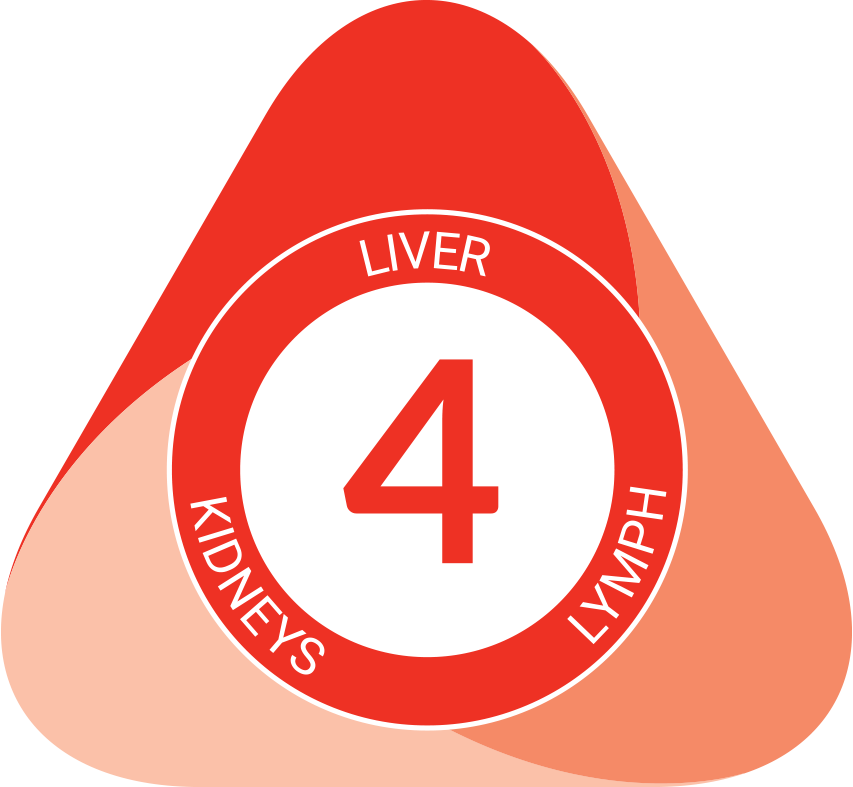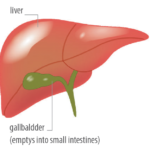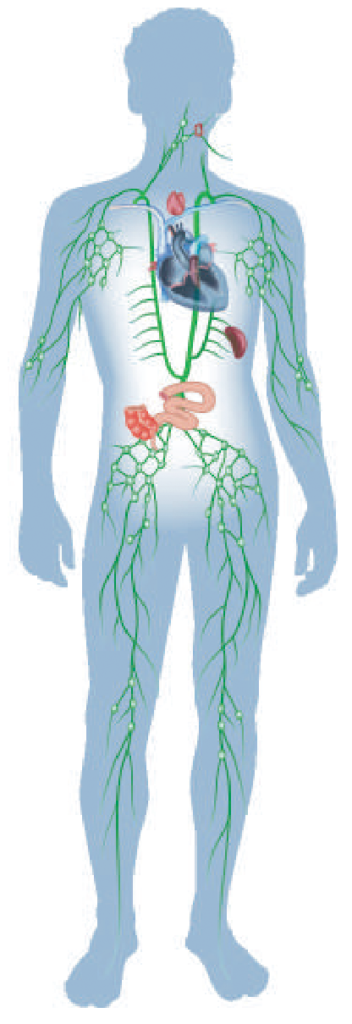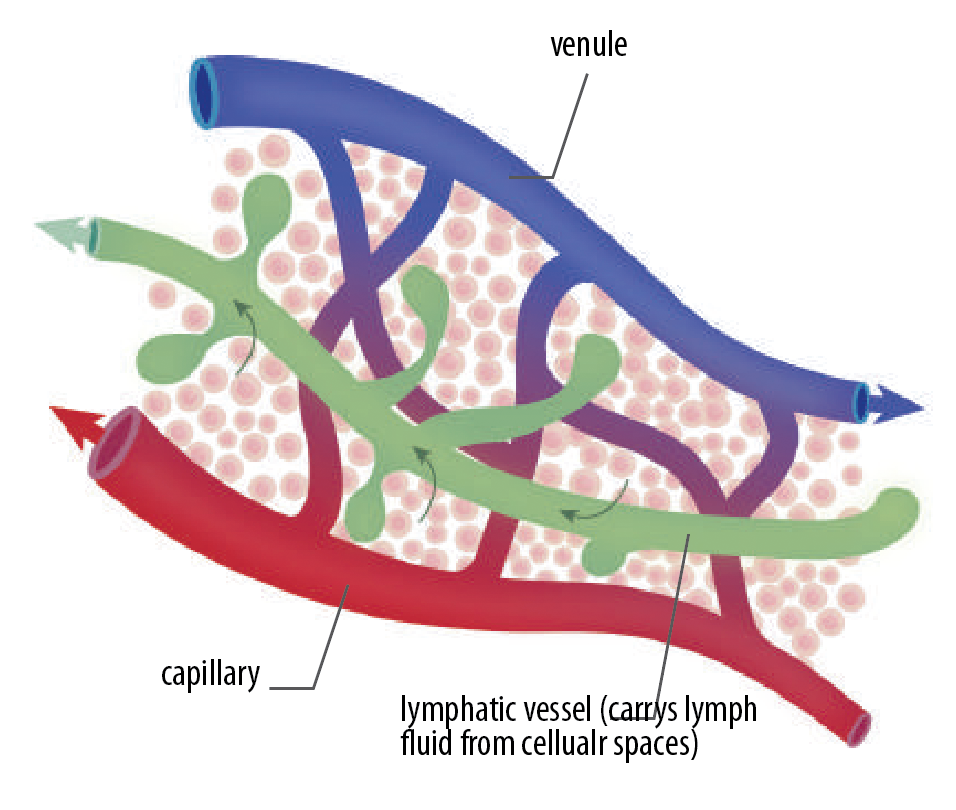
This TRIAD contains the drainage organs of the liver, lymph, and kidneys. These bodies form a functional unit for detoxification and elimination, metabolic processing and removal, and enzymatic activities. They allow the patient to thrive in a toxic world.
When Triad 4 is in harmony, there is a smooth flow of substrates and emotions, and when out of balance inflammation, stagnation, and retention ensues.

SUMMARY
The liver is the largest internal organ in the body located in the abdominal cavity. The liver is responsible for thousands of chemical functions within the body and for detoxifying our blood from bacteria, food contaminants, chemicals, alcohol and hormones. This detoxification process has two phases
IMPORTANCE
When the liver is operating optimally, phase one and phase two work efficiently at protecting the body against foreign substances. The system breaks down, however, when the rate of exposure to toxins is greater than it can handle.
Many health factors can cause imbalances in liver function leading to an unhealthy liver.
These factors include:
MORE INFORMATION:
 The liver is the body’s largest internal organ. An adult liver weighs approximately three pounds. It is located in the upper right quadrant of the abdominal cavity and extends beyond the midline. Anatomically, the liver consists of four lobes: a large right lobe, a smaller left lobe, and two inferior (bottom) lobes. The portal vein supplies the liver with blood from the gastrointestinal tract (including the stomach, and small and large intestines), spleen, and pancreas, while the hepatic artery supplies the liver with blood from the heart. Arteries take blood that has received oxygen to the organs, while veins take the “used” blood back to the lungs to get more oxygen. Together, the portal vein and hepatic artery pump about 1,400 ml (about 1.5 quarts) per minute into the liver. Because blood enters the liver faster than it is removed, the liver is able to store about 300 ml (a little less than one pint) of blood at any given time.
The liver is the body’s largest internal organ. An adult liver weighs approximately three pounds. It is located in the upper right quadrant of the abdominal cavity and extends beyond the midline. Anatomically, the liver consists of four lobes: a large right lobe, a smaller left lobe, and two inferior (bottom) lobes. The portal vein supplies the liver with blood from the gastrointestinal tract (including the stomach, and small and large intestines), spleen, and pancreas, while the hepatic artery supplies the liver with blood from the heart. Arteries take blood that has received oxygen to the organs, while veins take the “used” blood back to the lungs to get more oxygen. Together, the portal vein and hepatic artery pump about 1,400 ml (about 1.5 quarts) per minute into the liver. Because blood enters the liver faster than it is removed, the liver is able to store about 300 ml (a little less than one pint) of blood at any given time.
The liver contains cells called “Kupffer cells,” which are capable of removing dead cells, bacteria, and foreign substances from the blood. While the Kupffer cells are responsible for filtering about 99 percent of the bacterial and food contaminants from the blood, other important cells in the liver, termed hepatocytes, are active in the detoxification of drugs, heavy metals, chemicals, alcohol, and hormones. These processes of detoxification require two important steps, known as phase one (oxidation-reduction) and phase two (conjugation-elimination). The antioxidant glutathione is one of the most prevalent detoxifying chemicals in the liver.
The liver removes toxic and metabolic waste products from the body by converting them to water-soluble compounds that can be excreted in the urine. Those substances that are not water-soluble are transformed by the liver and excreted in the bile, a substance used for this purpose and for the digestion of fats. The bile is then transported into the intestines where it is eliminated in the feces. Toxins not completely removed by either one of these processes may be eliminated through the skin (fat-soluble compounds are excreted in sweat), or lungs. Toxins that remain in the body accumulate in the adipose (fat) tissue and nerve cells, contributing to a wide range of degenerative conditions.
In addition to filtering and detoxifying the blood, the liver contributes to the body’s anabolic and catabolic functions—that is, the reformation or building of new cells, tissues, and organs, and its opposite, the breakdown of cellular structure. The liver also functions as storage for glycogen, the stored form of glucose.
LIVER FUNCTIONS
Detoxifies chemicals from the environment via phase I and phase II detoxification Converts ammonia to urea Converts carbohydrates and proteins to fat Breaks down proteins Eliminates bilirubin (a substance secreted in the bile) Filters and detoxifies blood Forms ketones (waste products of partially metabolized fat) and phospholipids (fat molecules) from fatty acids Forms lipoproteins Metabolizes drugs Metabolizes hormones Produces bile salts Produces lymphatic fluid (lymph nourishes and cleanses tissue cells) Stores glycogen and converts it to glucose for fuel Stores vitamins A, D, B12, and the mineral iron Synthesizes cholesterol and enzymes Synthesizes blood-clotting factors Synthesizes plasma proteins (including globulin needed for antibody formation)
PHASE ONE DETOXIFICATION in the liver may be inhibited by a lack of nutrients, vitamins, or minerals.
SOME INHIBITORS OF PHASE-ONE DETOXIFICATION
SOME INDUCERS THAT ACCELERATE PHASE-ONE DETOXIFICATION INCLUDE:
KEY NUTRIENTS REQUIRED IN PHASE-ONE DETOXIFICATION
SOME INHIBITORS OF PHASE-TWO DETOXIFICATION
SOME INDUCERS THAT ENHANCE PHASE-TWO DETOXIFICATION INCLUDE:
KEY NUTRIENTS REQUIRED IN PHASE-TWO DETOXIFICATION

SUMMARY
The lymph system, or lymphatic system, is anatomically part of the circulatory system, and is a network of organs, lymph nodes, lymph ducts and lymph vessels. Lymphatic organs play a large part in our immunity. Organs that are intimately part of the lymphatic system include the spleen, thymus, bone marrow and lymphoid tissue associated with the digestive system (including the tonsils) – they produce immune cells to help us fight infection.
IMPORTANCE
The lymph is part of the immune system, which is interconnected with the gastrointestinal tract, the nervous system including memory, mood and cravings, with inflammatory processes, with hormonal balance (thyroid, sex hormone), sleep (melatonin balance), stress levels (cortisol balance), weight balance, nutrient supplies, energy, and all other metabolic processes. The lymph also helps the body remove toxins (including heavy metals, food chemical additives, plastics, pesticides, phthalates, which can impair metabolism.

MORE INFORMATION:
The lymph system, or lymphatic system, is anatomically part of the circulatory system, and is a network of organs, lymph nodes, lymph ducts and lymph vessels. The lymphatic vessels carry a clear fluid called lymph, derived from the Latin word lympha meaning “water goddess”, which is comprised of white blood cells and fluid from the intestines called “chyle”. White blood cells are part of your immune system that attacks foreign invaders in the body like bacteria and viruses; chyle contains proteins and fats and helps in digestion. The lymph fluid bathes the cells and tissues, removing particles like toxins and debris, and then it flows back into the bloodstream. The lymph only flows toward the heart, where it connects with the venous blood flow for recirculation or removal from the body.
Lymphatic organs play a large part in our immunity. Organs that are intimately part of the lymphatic system include the spleen, thymus, bone marrow and lymphoid tissue associated with the digestive system (including the tonsils) – they produce immune cells to help us fight infection.
The circulatory system processes about 20 liters (about 5.3 gallons) daily, with about 17 of these liters being reabsorbed directly into the blood, leaving 3 liters (0.8 gallons) that exists in between the cells. This fluid has to be removed, and that’s what lymph does. It helps remove the fluid between the cells and places it back into the blood. The lymph carries white blood cells to sites of infection and inflammation, and antigen presenting cells (also part of your immune system) to the lymph nodes, which initiate the white blood cells to attack.

SUMMARY
The kidneys filter our blood, removing toxins and waste while regulating water balance by controlling the flow of minerals called electrolytes (sodium, calcium, chloride, potassium) in and out of the body. The kidneys help regulate our body’s pH, or the acidity or alkalinity of the blood and body fluids. The kidneys help regulate our blood pressure and heart and blood vessel health. The kidneys also release an important hormone called erythropoietin, which helps stimulate more oxygen-carrying red blood cells to form in bone marrow.
IMPORTANCE
Kidney problems can develop from increased oxidative stress and inflammation that arise from various metabolic imbalances in the body. Chronic kidney problems occur more frequently with:
MORE INFORMATION:

The kidneys are reddish-brown, bean-shaped organs that are located in the back of the abdomen. A kidney is about 4-5 inches long, about the size of your fist. Each kidney contains about a million microscopic filtering units called nephrons.
1. Labs & Lifestyle Questionnaire
Take our signature comprehensive lab panel and lifestyle questionnaire to identify where your systems are currently out of balance.
2. Personalized Supplement Program
Based on your results take pharmaceutical grade and clinically tested supplements that are compounded specifically to address each TRIAD.
3. Metabolic Code Diet
Based on your profile you will get a detailed Metabolic Code Diet program that will significantly benefit your results and help you reach a healthy weight.
Thee most comprehensive personal assessment available.

Metabolic Code Enterprises, Inc.
Download a sample Metabolic Code® Report Here to see how you too can transform your lifestyle.
Metabolic Code® is a personalized health evaluation program that creates a precise plan of action for people to live and feel better.
Our cloud-based point-of-care system makes it easy to manage patient information, generate personalized wellness plans, and deliver health products right to your patient’s doorstep.
Experience what so many others have done to rapidly improve their health and vitality long-term. We have lifestyle programs created for people with all types of goals and dietary needs.